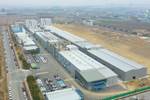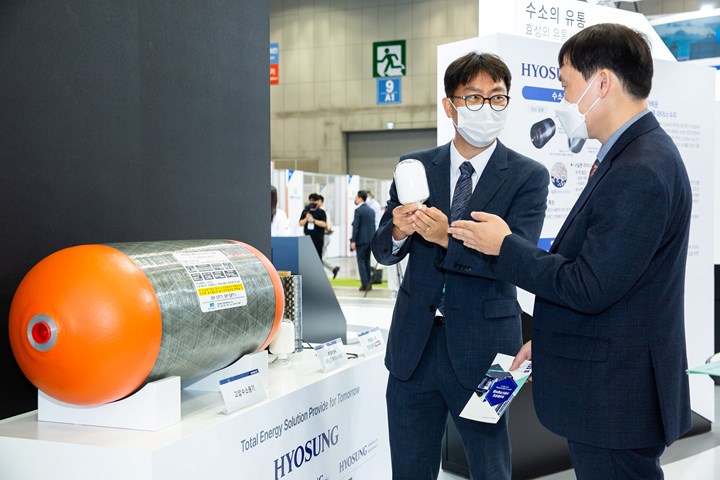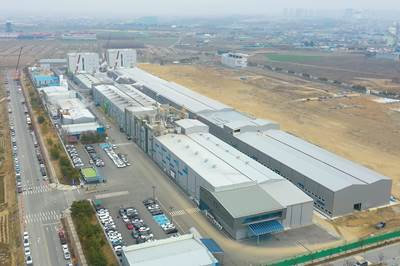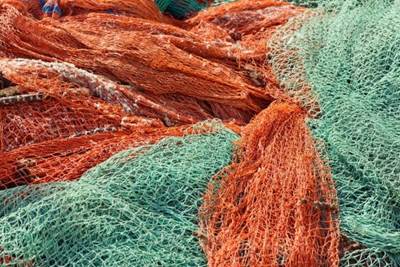Hyosung transforms nylon for use as liner in hydrogen fuel tanks
The company has succeeded in developing and using nylon as a core liner material in hydrogen storage vessels, overcoming metal and HDPE liner alternatives.
Hyosung TNC (Seoul, South Korea), a comprehensive fiber manufacturer, has announced that it has succeeded in developing and using nylon for the liner material — a core component to prevent gas leakage — of hydrogen vehicle fuel tanks with its own technology, the first of its kind for a Korean company.
Hyosung TNC’s nylon material is said to be superior to conventional metal and high-density polyethylene (HDPE) liner materials in terms of light weight, gas barrier and impact resistance. Specifically, the nylon liner material is 70% lighter than metal and 50% lighter than HDPE. Its gas barrier property is also reported to be 30% higher than metal and 50% higher than HDPE, effectively improving hydrogen gas leakage.
Conventional metal liners are heavy with a high risk of brittleness when exposed to hydrogen for a long period of time, whereas the nylon liner is said to have a low hydrogen absorption and air permeability, eliminating potential brittleness. HDPE liners, which are used as high-pressure containers at 400-bar levels, cannot withstand the 700-bar pressure required by typical hydrogen electric vehicles.
In addition, the hydrogen container liner must be able to withstand rapidly changing temperature fluctuation caused by frequent charging and discharging of hydrogen. Hyosung says this is solved through the nylon liner’s optimized impact resistance from -40ºC to 85ºC.
The development has laid the foundation for Hyosung TNC to enter the nylon liner market. According to H2 Research, the import substitution effect of the nylon material liner market is expected to grow to about 270 billion won (approximately $180 billion) annually in 2030. In addition, with the expansion of various hydrogen mobility markets such as hydrogen electric vehicles, drones, trams, ships and urban air mobility (UAM), nylon is expected to gain more attention as a liner material for hydrogen containers.
In addition, as Hyosung TNC works to develop what is says will be the first recycled nylon fiber technology from recycled fishing nets discarded in the sea.
Ultimately, the novel nylon liner is expected to contribute to the completion of Hyosung’s hydrogen value chain, which currently includes hydrogen charging stations in Korea, construction of liquefied hydrogen plants and liquefied hydrogen filling stations.
“Hyosung TNC’s development of nylon liner material demonstrates, even in the textile industry, which has been regarded as a declining industry, [that] the innovation that transforms it into a key material for the high-tech hydrogen industry can happen if it’s supported by technology,” chairman Cho Hyun-Joon says. “We will contribute to the development of the future eco-friendly energy industry with the technology of materials and textiles.”
Hyosung TNC’s nylon-applied hydrogen container passed the hydrogen container international quality standard (UN/ECE R134) in June 2022. The company also plans to conduct commercial tests in cooperation with hydrogen fuel tank manufacturers and automakers. It expects to expand the application of nylon as a liner material from tube trailers of commercial trucks to CNG and hydrogen vessels sailing the seas globally, such as Antarctica and the Equator, by enhancing the impact and heat resistance range from -60ºC to 90ºC.
In addition, as Hyosung TNC works to develop what is says will be the first recycled nylon fiber technology from recycled fishing nets discarded in the sea, it plans to expand the eco-friendly plastic material market by applying recycled nylon to a liner material in the future.
Related Content
Polar Technology develops innovative solutions for hydrogen storage
Conformable “Hydrogen in a Box” prototype for compressed gas storage has been tested to 350 and 700 bar, liquid hydrogen storage is being evaluated.
Read MoreNCC reaches milestone in composite cryogenic hydrogen program
The National Composites Centre is testing composite cryogenic storage tank demonstrators with increasing complexity, to support U.K. transition to the hydrogen economy.
Read MoreCollins Aerospace to lead COCOLIH2T project
Project for thermoplastic composite liquid hydrogen tanks aims for two demonstrators and TRL 4 by 2025.
Read MoreHexagon Purus opens new U.S. facility to manufacture composite hydrogen tanks
CW attends the opening of Westminster, Maryland, site and shares the company’s history, vision and leading role in H2 storage systems.
Read MoreRead Next
Hyosung to add fourth carbon fiber line in South Korea
The $38.5 million expansion will bring the company’s total carbon fiber capacity to 9,000 metric tonnes per year.
Read MoreAvient launches reclaimed nylon-based long fiber composites
The post-consumer recycled nylon 6 material is reclaimed from end-of-life fishing nets, reducing ocean-bound plastic waste while fostering material deployment for demanding environments.
Read MoreVIDEO: High-volume processing for fiberglass components
Cannon Ergos, a company specializing in high-ton presses and equipment for composites fabrication and plastics processing, displayed automotive and industrial components at CAMX 2024.
Read More



























